Management accounting concepts and techniques in decision making
VerifiedAdded on 2023/01/12
|13
|3124
|25
AI Summary
Contribute Materials
Your contribution can guide someone’s learning journey. Share your
documents today.
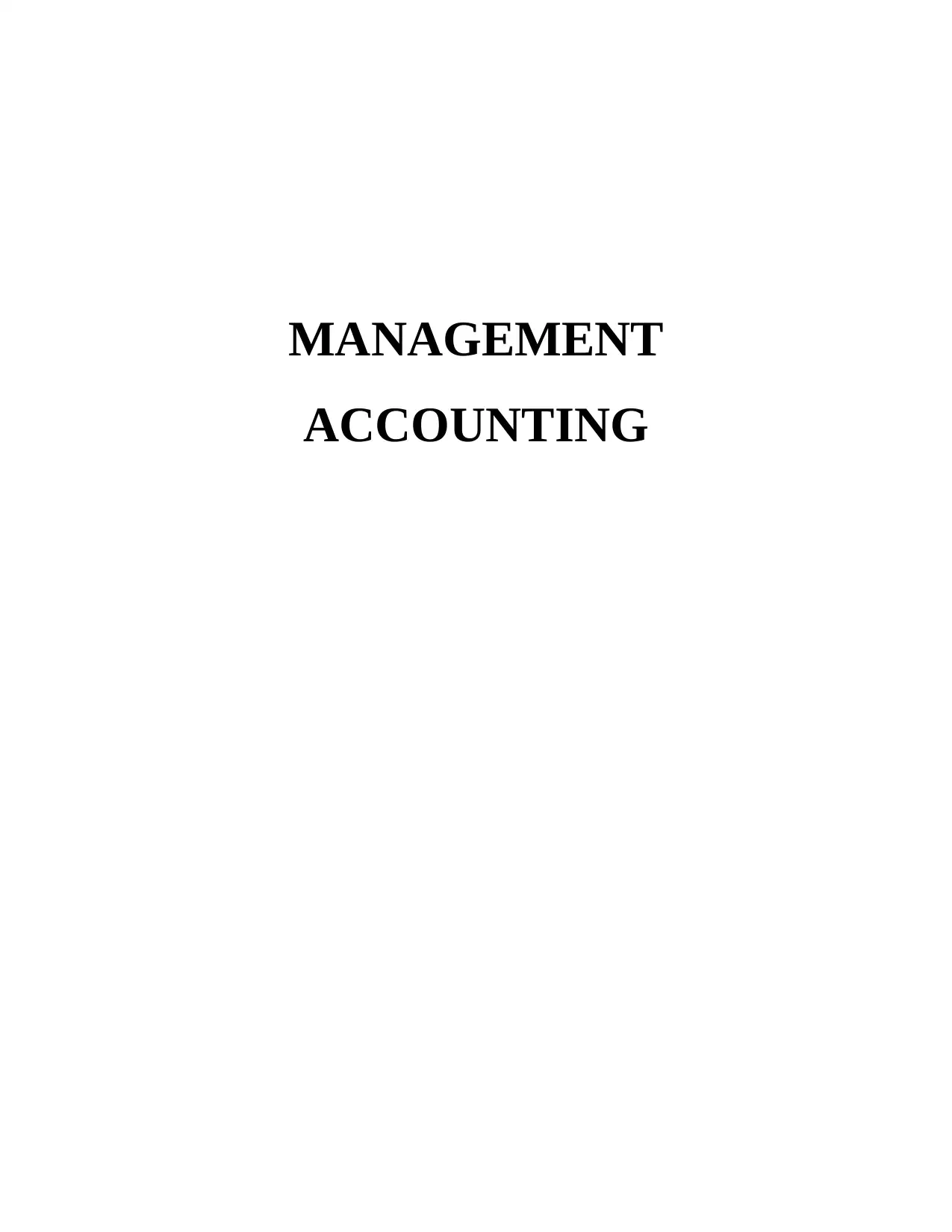
MANAGEMENT
ACCOUNTING
ACCOUNTING
Secure Best Marks with AI Grader
Need help grading? Try our AI Grader for instant feedback on your assignments.
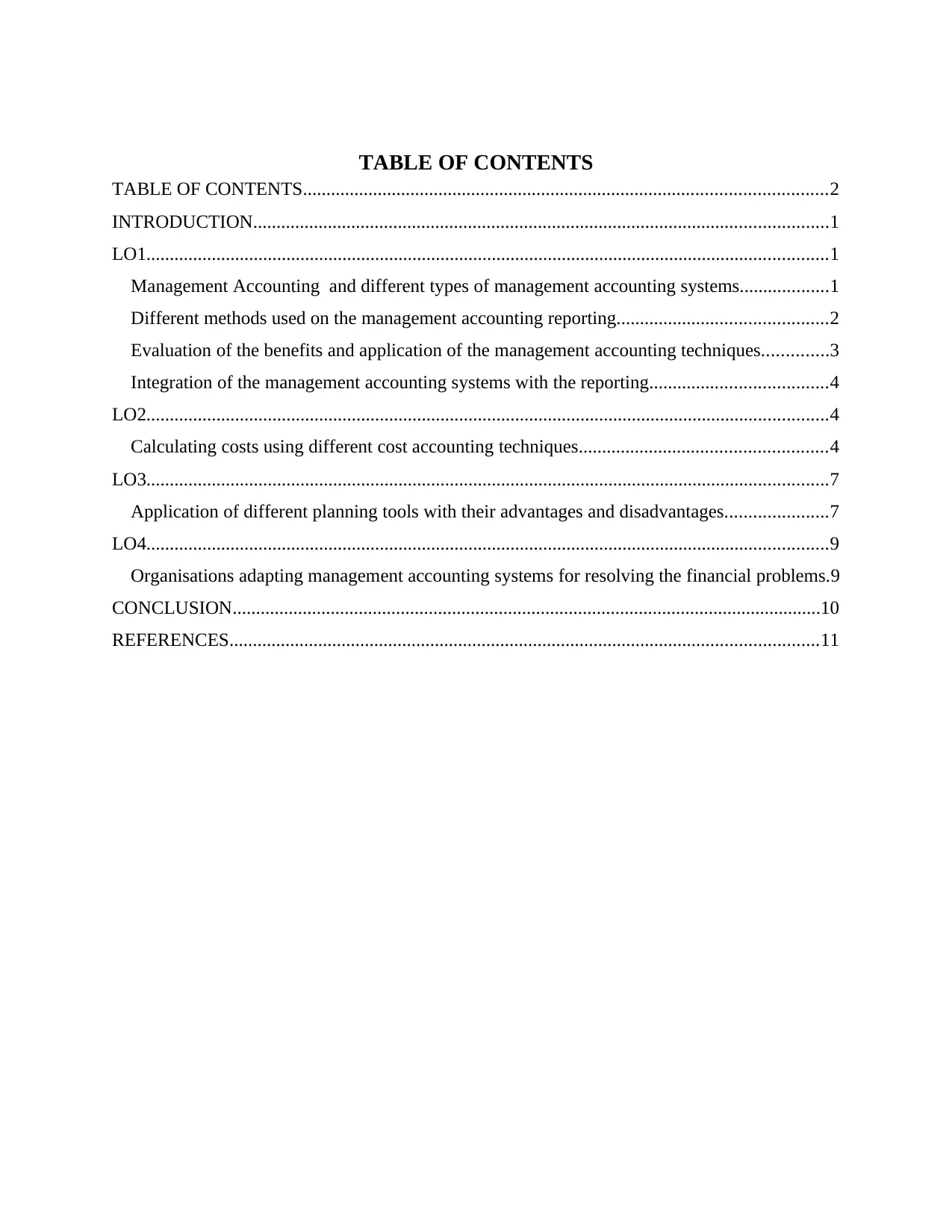
TABLE OF CONTENTS
TABLE OF CONTENTS................................................................................................................2
INTRODUCTION...........................................................................................................................1
LO1..................................................................................................................................................1
Management Accounting and different types of management accounting systems...................1
Different methods used on the management accounting reporting.............................................2
Evaluation of the benefits and application of the management accounting techniques..............3
Integration of the management accounting systems with the reporting......................................4
LO2..................................................................................................................................................4
Calculating costs using different cost accounting techniques.....................................................4
LO3..................................................................................................................................................7
Application of different planning tools with their advantages and disadvantages......................7
LO4..................................................................................................................................................9
Organisations adapting management accounting systems for resolving the financial problems.9
CONCLUSION..............................................................................................................................10
REFERENCES..............................................................................................................................11
TABLE OF CONTENTS................................................................................................................2
INTRODUCTION...........................................................................................................................1
LO1..................................................................................................................................................1
Management Accounting and different types of management accounting systems...................1
Different methods used on the management accounting reporting.............................................2
Evaluation of the benefits and application of the management accounting techniques..............3
Integration of the management accounting systems with the reporting......................................4
LO2..................................................................................................................................................4
Calculating costs using different cost accounting techniques.....................................................4
LO3..................................................................................................................................................7
Application of different planning tools with their advantages and disadvantages......................7
LO4..................................................................................................................................................9
Organisations adapting management accounting systems for resolving the financial problems.9
CONCLUSION..............................................................................................................................10
REFERENCES..............................................................................................................................11
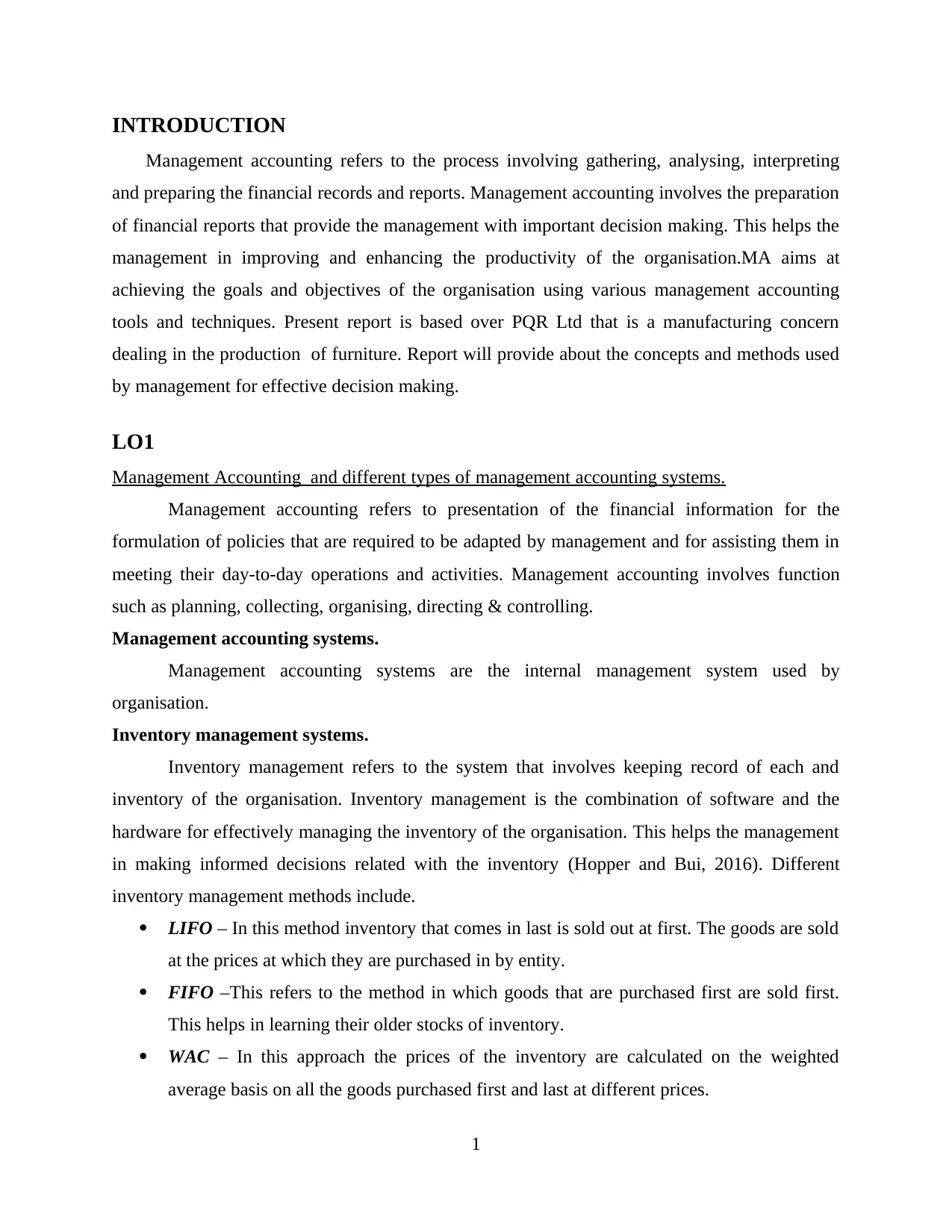
INTRODUCTION
Management accounting refers to the process involving gathering, analysing, interpreting
and preparing the financial records and reports. Management accounting involves the preparation
of financial reports that provide the management with important decision making. This helps the
management in improving and enhancing the productivity of the organisation.MA aims at
achieving the goals and objectives of the organisation using various management accounting
tools and techniques. Present report is based over PQR Ltd that is a manufacturing concern
dealing in the production of furniture. Report will provide about the concepts and methods used
by management for effective decision making.
LO1
Management Accounting and different types of management accounting systems.
Management accounting refers to presentation of the financial information for the
formulation of policies that are required to be adapted by management and for assisting them in
meeting their day-to-day operations and activities. Management accounting involves function
such as planning, collecting, organising, directing & controlling.
Management accounting systems.
Management accounting systems are the internal management system used by
organisation.
Inventory management systems.
Inventory management refers to the system that involves keeping record of each and
inventory of the organisation. Inventory management is the combination of software and the
hardware for effectively managing the inventory of the organisation. This helps the management
in making informed decisions related with the inventory (Hopper and Bui, 2016). Different
inventory management methods include.
LIFO – In this method inventory that comes in last is sold out at first. The goods are sold
at the prices at which they are purchased in by entity.
FIFO –This refers to the method in which goods that are purchased first are sold first.
This helps in learning their older stocks of inventory.
WAC – In this approach the prices of the inventory are calculated on the weighted
average basis on all the goods purchased first and last at different prices.
1
Management accounting refers to the process involving gathering, analysing, interpreting
and preparing the financial records and reports. Management accounting involves the preparation
of financial reports that provide the management with important decision making. This helps the
management in improving and enhancing the productivity of the organisation.MA aims at
achieving the goals and objectives of the organisation using various management accounting
tools and techniques. Present report is based over PQR Ltd that is a manufacturing concern
dealing in the production of furniture. Report will provide about the concepts and methods used
by management for effective decision making.
LO1
Management Accounting and different types of management accounting systems.
Management accounting refers to presentation of the financial information for the
formulation of policies that are required to be adapted by management and for assisting them in
meeting their day-to-day operations and activities. Management accounting involves function
such as planning, collecting, organising, directing & controlling.
Management accounting systems.
Management accounting systems are the internal management system used by
organisation.
Inventory management systems.
Inventory management refers to the system that involves keeping record of each and
inventory of the organisation. Inventory management is the combination of software and the
hardware for effectively managing the inventory of the organisation. This helps the management
in making informed decisions related with the inventory (Hopper and Bui, 2016). Different
inventory management methods include.
LIFO – In this method inventory that comes in last is sold out at first. The goods are sold
at the prices at which they are purchased in by entity.
FIFO –This refers to the method in which goods that are purchased first are sold first.
This helps in learning their older stocks of inventory.
WAC – In this approach the prices of the inventory are calculated on the weighted
average basis on all the goods purchased first and last at different prices.
1
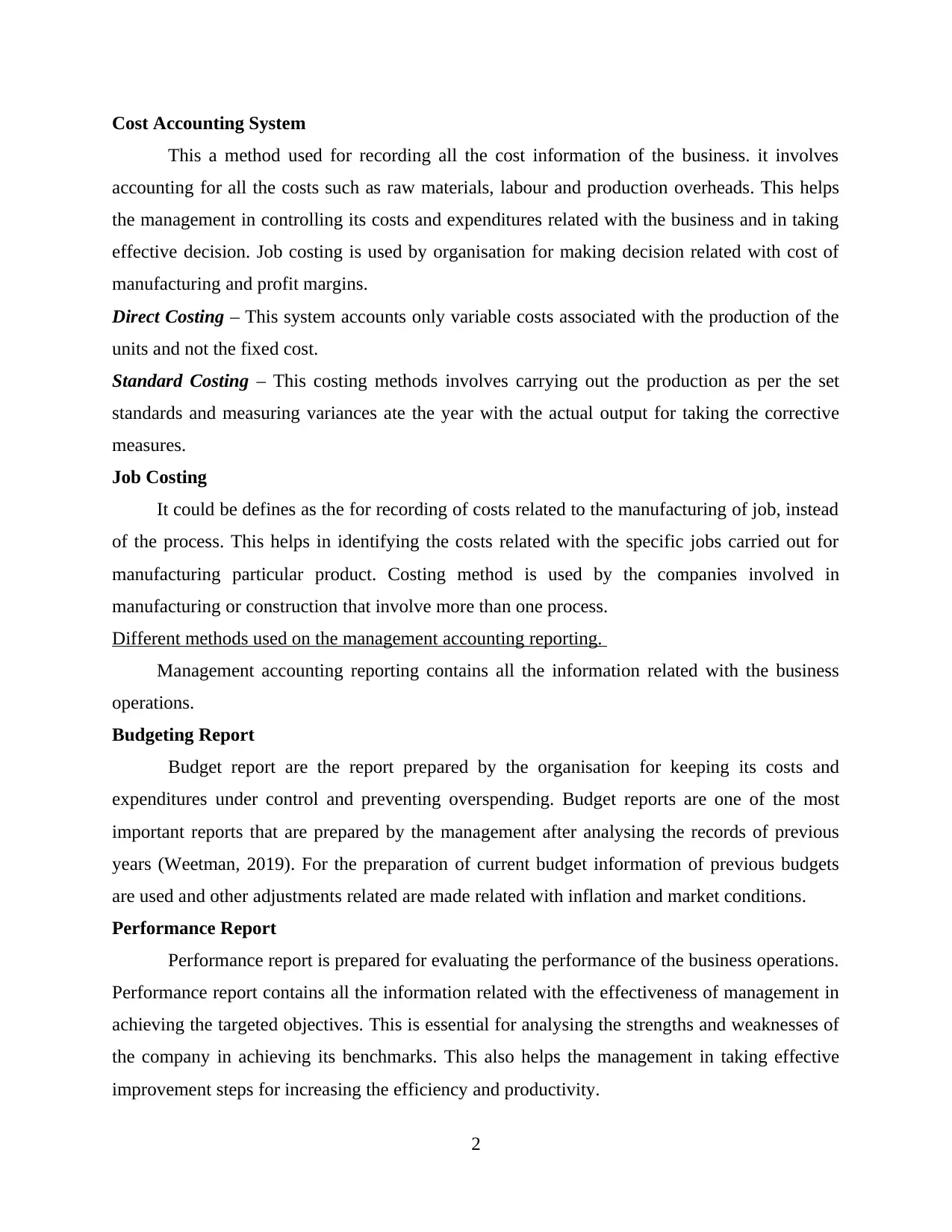
Cost Accounting System
This a method used for recording all the cost information of the business. it involves
accounting for all the costs such as raw materials, labour and production overheads. This helps
the management in controlling its costs and expenditures related with the business and in taking
effective decision. Job costing is used by organisation for making decision related with cost of
manufacturing and profit margins.
Direct Costing – This system accounts only variable costs associated with the production of the
units and not the fixed cost.
Standard Costing – This costing methods involves carrying out the production as per the set
standards and measuring variances ate the year with the actual output for taking the corrective
measures.
Job Costing
It could be defines as the for recording of costs related to the manufacturing of job, instead
of the process. This helps in identifying the costs related with the specific jobs carried out for
manufacturing particular product. Costing method is used by the companies involved in
manufacturing or construction that involve more than one process.
Different methods used on the management accounting reporting.
Management accounting reporting contains all the information related with the business
operations.
Budgeting Report
Budget report are the report prepared by the organisation for keeping its costs and
expenditures under control and preventing overspending. Budget reports are one of the most
important reports that are prepared by the management after analysing the records of previous
years (Weetman, 2019). For the preparation of current budget information of previous budgets
are used and other adjustments related are made related with inflation and market conditions.
Performance Report
Performance report is prepared for evaluating the performance of the business operations.
Performance report contains all the information related with the effectiveness of management in
achieving the targeted objectives. This is essential for analysing the strengths and weaknesses of
the company in achieving its benchmarks. This also helps the management in taking effective
improvement steps for increasing the efficiency and productivity.
2
This a method used for recording all the cost information of the business. it involves
accounting for all the costs such as raw materials, labour and production overheads. This helps
the management in controlling its costs and expenditures related with the business and in taking
effective decision. Job costing is used by organisation for making decision related with cost of
manufacturing and profit margins.
Direct Costing – This system accounts only variable costs associated with the production of the
units and not the fixed cost.
Standard Costing – This costing methods involves carrying out the production as per the set
standards and measuring variances ate the year with the actual output for taking the corrective
measures.
Job Costing
It could be defines as the for recording of costs related to the manufacturing of job, instead
of the process. This helps in identifying the costs related with the specific jobs carried out for
manufacturing particular product. Costing method is used by the companies involved in
manufacturing or construction that involve more than one process.
Different methods used on the management accounting reporting.
Management accounting reporting contains all the information related with the business
operations.
Budgeting Report
Budget report are the report prepared by the organisation for keeping its costs and
expenditures under control and preventing overspending. Budget reports are one of the most
important reports that are prepared by the management after analysing the records of previous
years (Weetman, 2019). For the preparation of current budget information of previous budgets
are used and other adjustments related are made related with inflation and market conditions.
Performance Report
Performance report is prepared for evaluating the performance of the business operations.
Performance report contains all the information related with the effectiveness of management in
achieving the targeted objectives. This is essential for analysing the strengths and weaknesses of
the company in achieving its benchmarks. This also helps the management in taking effective
improvement steps for increasing the efficiency and productivity.
2
Secure Best Marks with AI Grader
Need help grading? Try our AI Grader for instant feedback on your assignments.
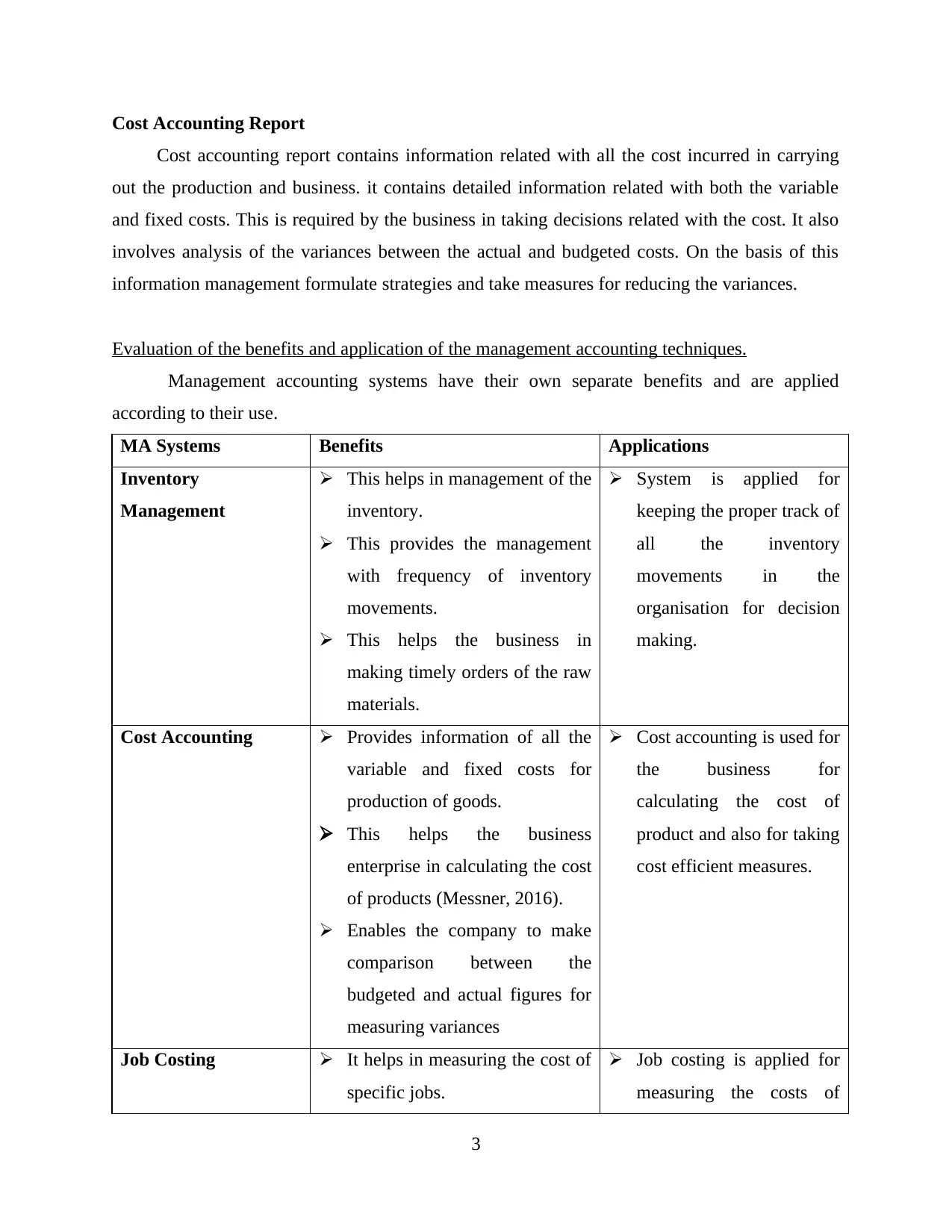
Cost Accounting Report
Cost accounting report contains information related with all the cost incurred in carrying
out the production and business. it contains detailed information related with both the variable
and fixed costs. This is required by the business in taking decisions related with the cost. It also
involves analysis of the variances between the actual and budgeted costs. On the basis of this
information management formulate strategies and take measures for reducing the variances.
Evaluation of the benefits and application of the management accounting techniques.
Management accounting systems have their own separate benefits and are applied
according to their use.
MA Systems Benefits Applications
Inventory
Management
This helps in management of the
inventory.
This provides the management
with frequency of inventory
movements.
This helps the business in
making timely orders of the raw
materials.
System is applied for
keeping the proper track of
all the inventory
movements in the
organisation for decision
making.
Cost Accounting Provides information of all the
variable and fixed costs for
production of goods.
This helps the business
enterprise in calculating the cost
of products (Messner, 2016).
Enables the company to make
comparison between the
budgeted and actual figures for
measuring variances
Cost accounting is used for
the business for
calculating the cost of
product and also for taking
cost efficient measures.
Job Costing It helps in measuring the cost of
specific jobs.
Job costing is applied for
measuring the costs of
3
Cost accounting report contains information related with all the cost incurred in carrying
out the production and business. it contains detailed information related with both the variable
and fixed costs. This is required by the business in taking decisions related with the cost. It also
involves analysis of the variances between the actual and budgeted costs. On the basis of this
information management formulate strategies and take measures for reducing the variances.
Evaluation of the benefits and application of the management accounting techniques.
Management accounting systems have their own separate benefits and are applied
according to their use.
MA Systems Benefits Applications
Inventory
Management
This helps in management of the
inventory.
This provides the management
with frequency of inventory
movements.
This helps the business in
making timely orders of the raw
materials.
System is applied for
keeping the proper track of
all the inventory
movements in the
organisation for decision
making.
Cost Accounting Provides information of all the
variable and fixed costs for
production of goods.
This helps the business
enterprise in calculating the cost
of products (Messner, 2016).
Enables the company to make
comparison between the
budgeted and actual figures for
measuring variances
Cost accounting is used for
the business for
calculating the cost of
product and also for taking
cost efficient measures.
Job Costing It helps in measuring the cost of
specific jobs.
Job costing is applied for
measuring the costs of
3
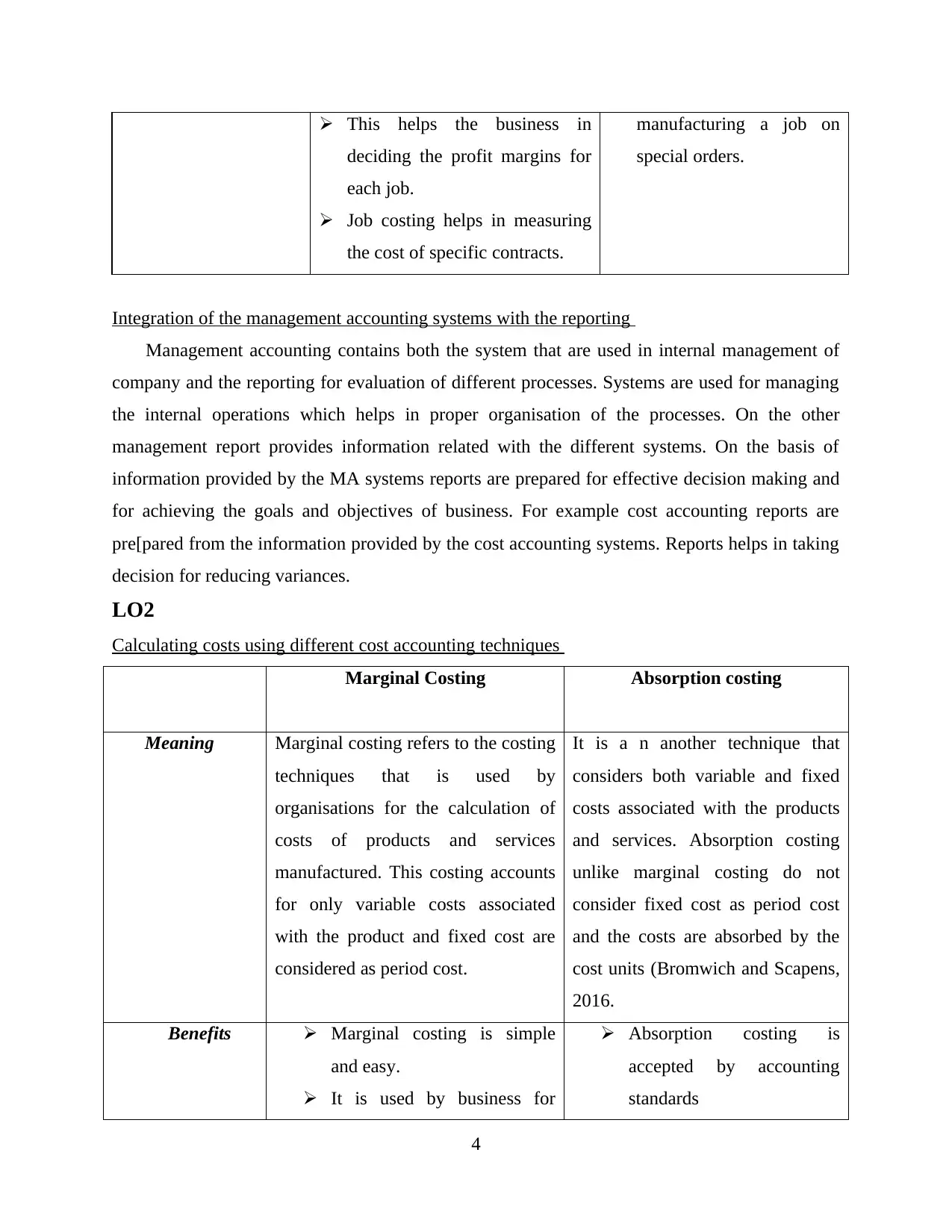
This helps the business in
deciding the profit margins for
each job.
Job costing helps in measuring
the cost of specific contracts.
manufacturing a job on
special orders.
Integration of the management accounting systems with the reporting
Management accounting contains both the system that are used in internal management of
company and the reporting for evaluation of different processes. Systems are used for managing
the internal operations which helps in proper organisation of the processes. On the other
management report provides information related with the different systems. On the basis of
information provided by the MA systems reports are prepared for effective decision making and
for achieving the goals and objectives of business. For example cost accounting reports are
pre[pared from the information provided by the cost accounting systems. Reports helps in taking
decision for reducing variances.
LO2
Calculating costs using different cost accounting techniques
Marginal Costing Absorption costing
Meaning Marginal costing refers to the costing
techniques that is used by
organisations for the calculation of
costs of products and services
manufactured. This costing accounts
for only variable costs associated
with the product and fixed cost are
considered as period cost.
It is a n another technique that
considers both variable and fixed
costs associated with the products
and services. Absorption costing
unlike marginal costing do not
consider fixed cost as period cost
and the costs are absorbed by the
cost units (Bromwich and Scapens,
2016.
Benefits Marginal costing is simple
and easy.
It is used by business for
Absorption costing is
accepted by accounting
standards
4
deciding the profit margins for
each job.
Job costing helps in measuring
the cost of specific contracts.
manufacturing a job on
special orders.
Integration of the management accounting systems with the reporting
Management accounting contains both the system that are used in internal management of
company and the reporting for evaluation of different processes. Systems are used for managing
the internal operations which helps in proper organisation of the processes. On the other
management report provides information related with the different systems. On the basis of
information provided by the MA systems reports are prepared for effective decision making and
for achieving the goals and objectives of business. For example cost accounting reports are
pre[pared from the information provided by the cost accounting systems. Reports helps in taking
decision for reducing variances.
LO2
Calculating costs using different cost accounting techniques
Marginal Costing Absorption costing
Meaning Marginal costing refers to the costing
techniques that is used by
organisations for the calculation of
costs of products and services
manufactured. This costing accounts
for only variable costs associated
with the product and fixed cost are
considered as period cost.
It is a n another technique that
considers both variable and fixed
costs associated with the products
and services. Absorption costing
unlike marginal costing do not
consider fixed cost as period cost
and the costs are absorbed by the
cost units (Bromwich and Scapens,
2016.
Benefits Marginal costing is simple
and easy.
It is used by business for
Absorption costing is
accepted by accounting
standards
4
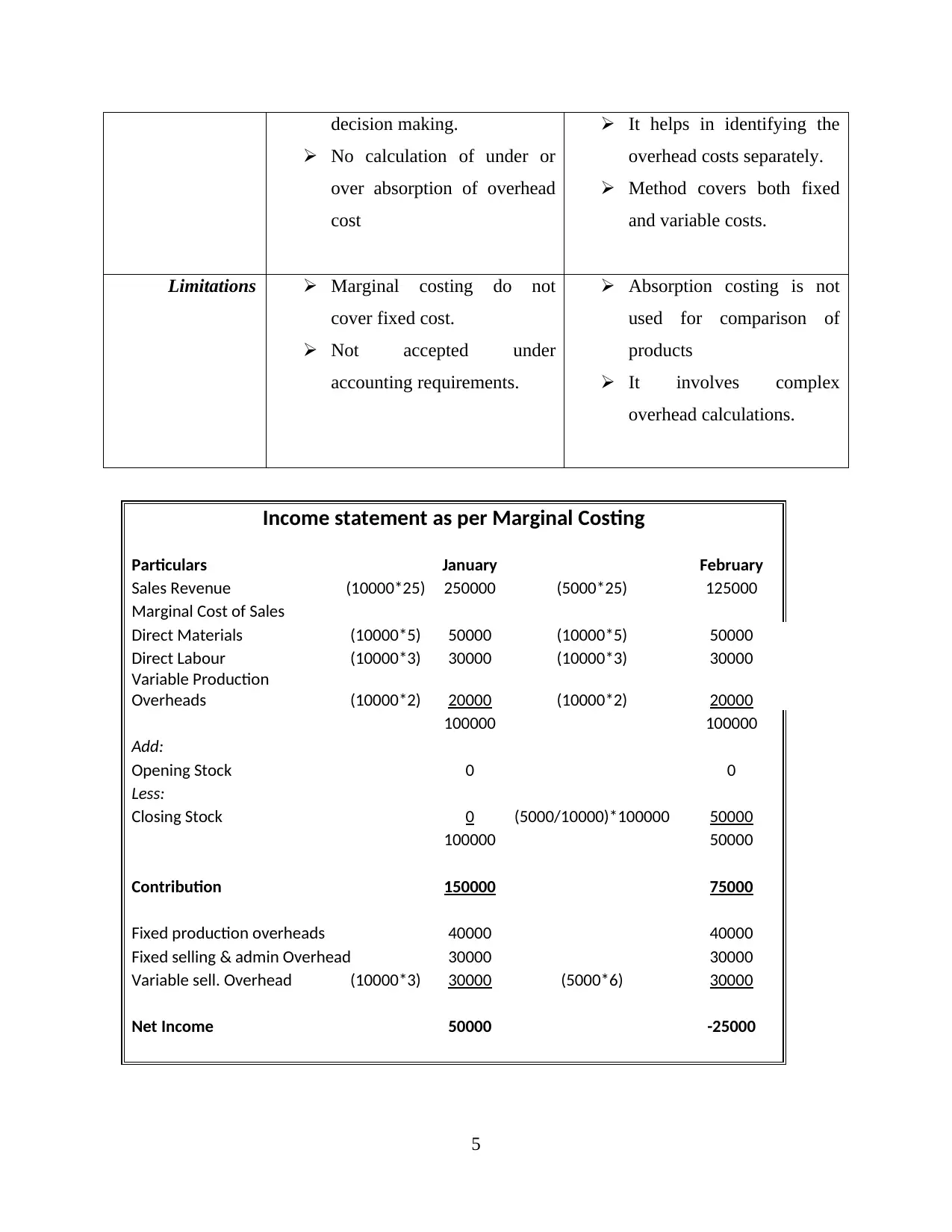
decision making.
No calculation of under or
over absorption of overhead
cost
It helps in identifying the
overhead costs separately.
Method covers both fixed
and variable costs.
Limitations Marginal costing do not
cover fixed cost.
Not accepted under
accounting requirements.
Absorption costing is not
used for comparison of
products
It involves complex
overhead calculations.
Income statement as per Marginal Costing
Particulars January February
Sales Revenue (10000*25) 250000 (5000*25) 125000
Marginal Cost of Sales
Direct Materials (10000*5) 50000 (10000*5) 50000
Direct Labour (10000*3) 30000 (10000*3) 30000
Variable Production
Overheads (10000*2) 20000 (10000*2) 20000
100000 100000
Add:
Opening Stock 0 0
Less:
Closing Stock 0 (5000/10000)*100000 50000
100000 50000
Contribution 150000 75000
Fixed production overheads 40000 40000
Fixed selling & admin Overhead 30000 30000
Variable sell. Overhead (10000*3) 30000 (5000*6) 30000
Net Income 50000 -25000
5
No calculation of under or
over absorption of overhead
cost
It helps in identifying the
overhead costs separately.
Method covers both fixed
and variable costs.
Limitations Marginal costing do not
cover fixed cost.
Not accepted under
accounting requirements.
Absorption costing is not
used for comparison of
products
It involves complex
overhead calculations.
Income statement as per Marginal Costing
Particulars January February
Sales Revenue (10000*25) 250000 (5000*25) 125000
Marginal Cost of Sales
Direct Materials (10000*5) 50000 (10000*5) 50000
Direct Labour (10000*3) 30000 (10000*3) 30000
Variable Production
Overheads (10000*2) 20000 (10000*2) 20000
100000 100000
Add:
Opening Stock 0 0
Less:
Closing Stock 0 (5000/10000)*100000 50000
100000 50000
Contribution 150000 75000
Fixed production overheads 40000 40000
Fixed selling & admin Overhead 30000 30000
Variable sell. Overhead (10000*3) 30000 (5000*6) 30000
Net Income 50000 -25000
5
Paraphrase This Document
Need a fresh take? Get an instant paraphrase of this document with our AI Paraphraser
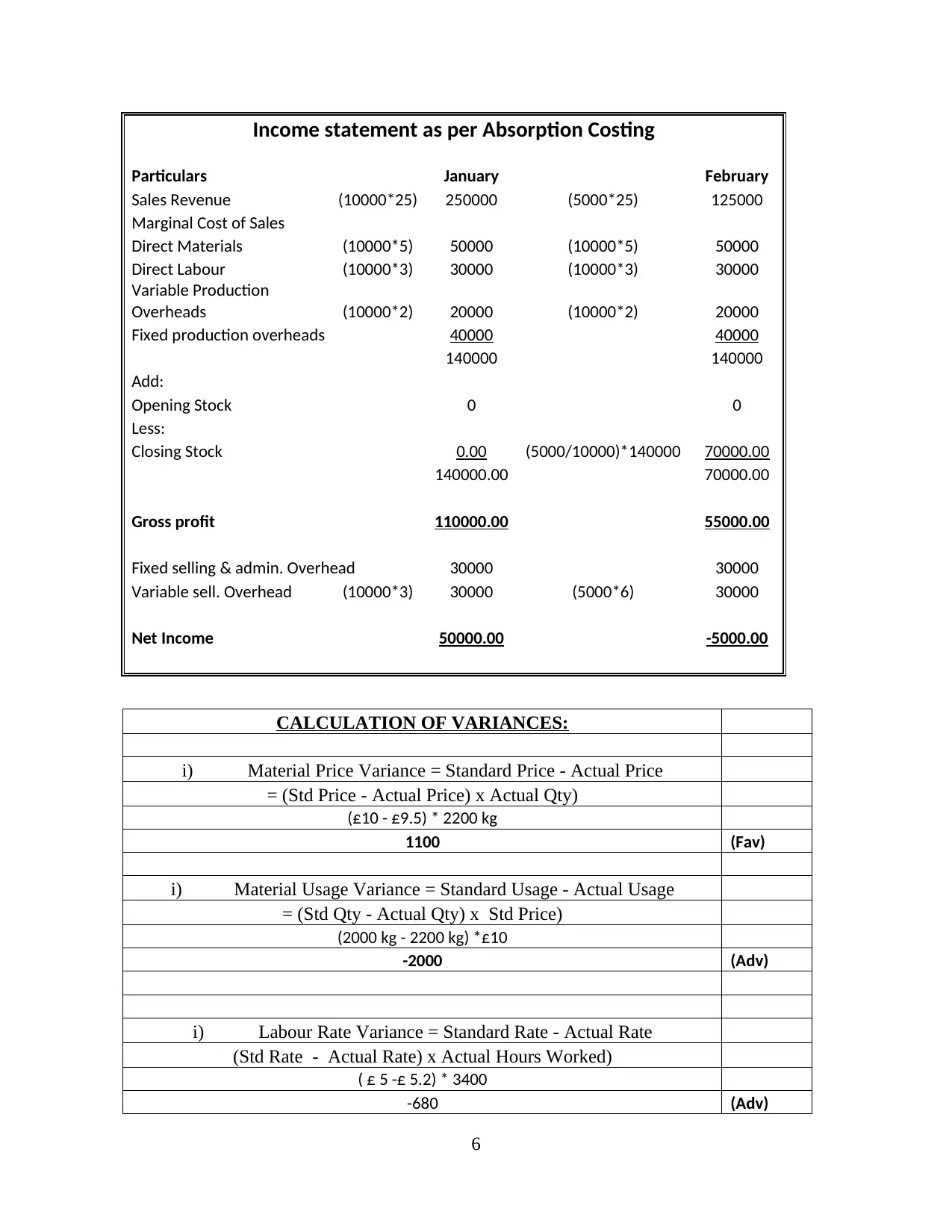
Income statement as per Absorption Costing
Particulars January February
Sales Revenue (10000*25) 250000 (5000*25) 125000
Marginal Cost of Sales
Direct Materials (10000*5) 50000 (10000*5) 50000
Direct Labour (10000*3) 30000 (10000*3) 30000
Variable Production
Overheads (10000*2) 20000 (10000*2) 20000
Fixed production overheads 40000 40000
140000 140000
Add:
Opening Stock 0 0
Less:
Closing Stock 0.00 (5000/10000)*140000 70000.00
140000.00 70000.00
Gross profit 110000.00 55000.00
Fixed selling & admin. Overhead 30000 30000
Variable sell. Overhead (10000*3) 30000 (5000*6) 30000
Net Income 50000.00 -5000.00
CALCULATION OF VARIANCES:
i) Material Price Variance = Standard Price - Actual Price
= (Std Price - Actual Price) x Actual Qty)
(£10 - £9.5) * 2200 kg
1100 (Fav)
i) Material Usage Variance = Standard Usage - Actual Usage
= (Std Qty - Actual Qty) x Std Price)
(2000 kg - 2200 kg) *£10
-2000 (Adv)
i) Labour Rate Variance = Standard Rate - Actual Rate
(Std Rate - Actual Rate) x Actual Hours Worked)
( £ 5 -£ 5.2) * 3400
-680 (Adv)
6
Particulars January February
Sales Revenue (10000*25) 250000 (5000*25) 125000
Marginal Cost of Sales
Direct Materials (10000*5) 50000 (10000*5) 50000
Direct Labour (10000*3) 30000 (10000*3) 30000
Variable Production
Overheads (10000*2) 20000 (10000*2) 20000
Fixed production overheads 40000 40000
140000 140000
Add:
Opening Stock 0 0
Less:
Closing Stock 0.00 (5000/10000)*140000 70000.00
140000.00 70000.00
Gross profit 110000.00 55000.00
Fixed selling & admin. Overhead 30000 30000
Variable sell. Overhead (10000*3) 30000 (5000*6) 30000
Net Income 50000.00 -5000.00
CALCULATION OF VARIANCES:
i) Material Price Variance = Standard Price - Actual Price
= (Std Price - Actual Price) x Actual Qty)
(£10 - £9.5) * 2200 kg
1100 (Fav)
i) Material Usage Variance = Standard Usage - Actual Usage
= (Std Qty - Actual Qty) x Std Price)
(2000 kg - 2200 kg) *£10
-2000 (Adv)
i) Labour Rate Variance = Standard Rate - Actual Rate
(Std Rate - Actual Rate) x Actual Hours Worked)
( £ 5 -£ 5.2) * 3400
-680 (Adv)
6
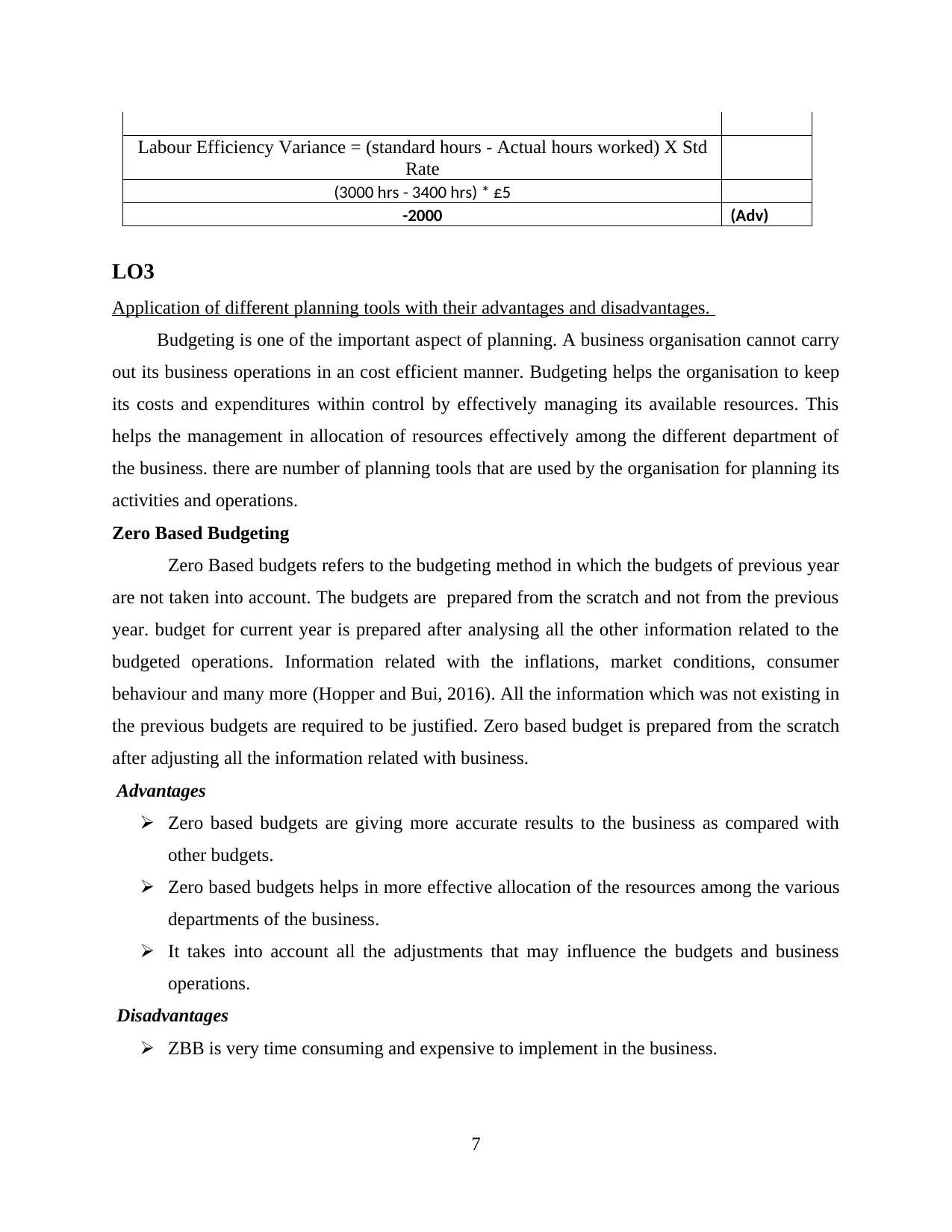
Labour Efficiency Variance = (standard hours - Actual hours worked) X Std
Rate
(3000 hrs - 3400 hrs) * £5
-2000 (Adv)
LO3
Application of different planning tools with their advantages and disadvantages.
Budgeting is one of the important aspect of planning. A business organisation cannot carry
out its business operations in an cost efficient manner. Budgeting helps the organisation to keep
its costs and expenditures within control by effectively managing its available resources. This
helps the management in allocation of resources effectively among the different department of
the business. there are number of planning tools that are used by the organisation for planning its
activities and operations.
Zero Based Budgeting
Zero Based budgets refers to the budgeting method in which the budgets of previous year
are not taken into account. The budgets are prepared from the scratch and not from the previous
year. budget for current year is prepared after analysing all the other information related to the
budgeted operations. Information related with the inflations, market conditions, consumer
behaviour and many more (Hopper and Bui, 2016). All the information which was not existing in
the previous budgets are required to be justified. Zero based budget is prepared from the scratch
after adjusting all the information related with business.
Advantages
Zero based budgets are giving more accurate results to the business as compared with
other budgets.
Zero based budgets helps in more effective allocation of the resources among the various
departments of the business.
It takes into account all the adjustments that may influence the budgets and business
operations.
Disadvantages
ZBB is very time consuming and expensive to implement in the business.
7
Rate
(3000 hrs - 3400 hrs) * £5
-2000 (Adv)
LO3
Application of different planning tools with their advantages and disadvantages.
Budgeting is one of the important aspect of planning. A business organisation cannot carry
out its business operations in an cost efficient manner. Budgeting helps the organisation to keep
its costs and expenditures within control by effectively managing its available resources. This
helps the management in allocation of resources effectively among the different department of
the business. there are number of planning tools that are used by the organisation for planning its
activities and operations.
Zero Based Budgeting
Zero Based budgets refers to the budgeting method in which the budgets of previous year
are not taken into account. The budgets are prepared from the scratch and not from the previous
year. budget for current year is prepared after analysing all the other information related to the
budgeted operations. Information related with the inflations, market conditions, consumer
behaviour and many more (Hopper and Bui, 2016). All the information which was not existing in
the previous budgets are required to be justified. Zero based budget is prepared from the scratch
after adjusting all the information related with business.
Advantages
Zero based budgets are giving more accurate results to the business as compared with
other budgets.
Zero based budgets helps in more effective allocation of the resources among the various
departments of the business.
It takes into account all the adjustments that may influence the budgets and business
operations.
Disadvantages
ZBB is very time consuming and expensive to implement in the business.
7
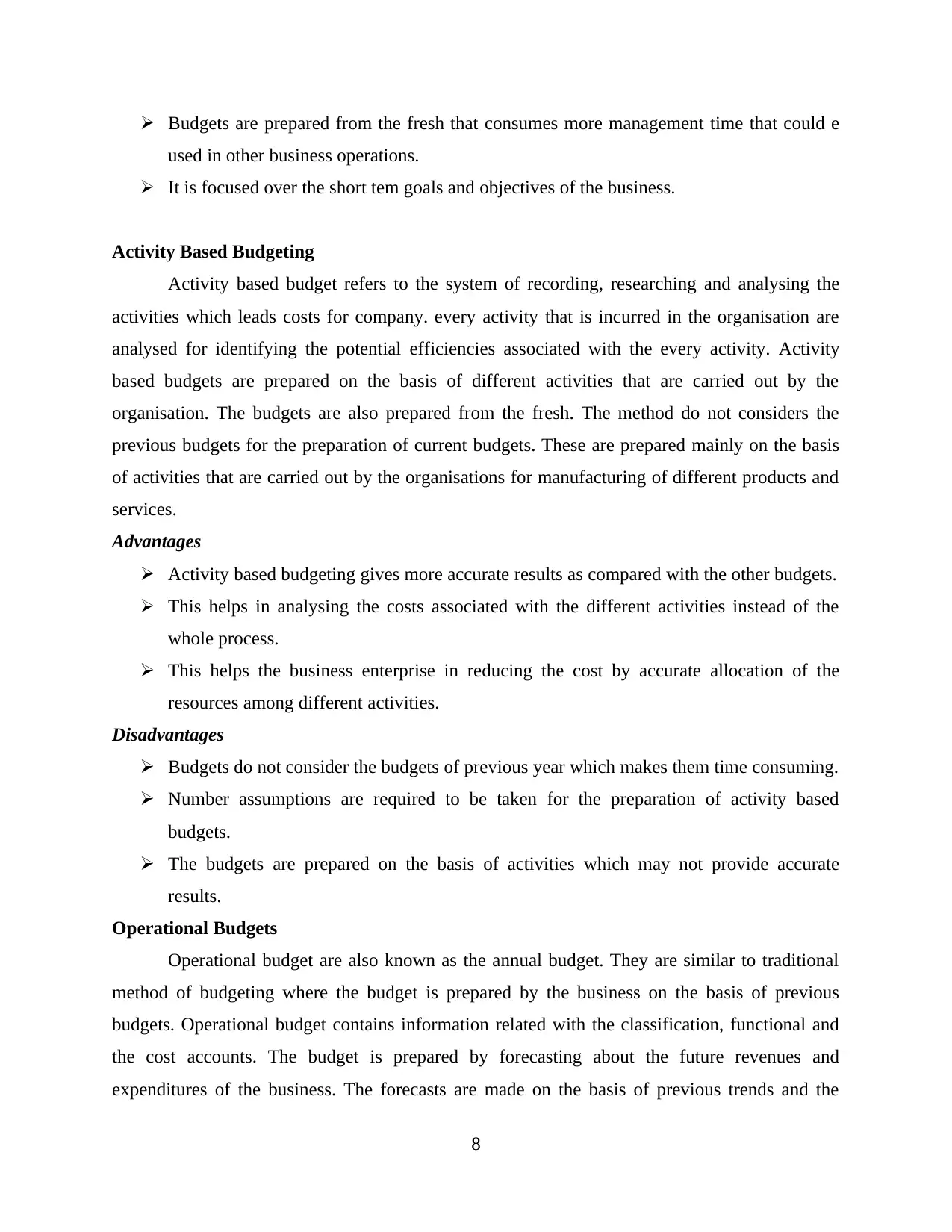
Budgets are prepared from the fresh that consumes more management time that could e
used in other business operations.
It is focused over the short tem goals and objectives of the business.
Activity Based Budgeting
Activity based budget refers to the system of recording, researching and analysing the
activities which leads costs for company. every activity that is incurred in the organisation are
analysed for identifying the potential efficiencies associated with the every activity. Activity
based budgets are prepared on the basis of different activities that are carried out by the
organisation. The budgets are also prepared from the fresh. The method do not considers the
previous budgets for the preparation of current budgets. These are prepared mainly on the basis
of activities that are carried out by the organisations for manufacturing of different products and
services.
Advantages
Activity based budgeting gives more accurate results as compared with the other budgets.
This helps in analysing the costs associated with the different activities instead of the
whole process.
This helps the business enterprise in reducing the cost by accurate allocation of the
resources among different activities.
Disadvantages
Budgets do not consider the budgets of previous year which makes them time consuming.
Number assumptions are required to be taken for the preparation of activity based
budgets.
The budgets are prepared on the basis of activities which may not provide accurate
results.
Operational Budgets
Operational budget are also known as the annual budget. They are similar to traditional
method of budgeting where the budget is prepared by the business on the basis of previous
budgets. Operational budget contains information related with the classification, functional and
the cost accounts. The budget is prepared by forecasting about the future revenues and
expenditures of the business. The forecasts are made on the basis of previous trends and the
8
used in other business operations.
It is focused over the short tem goals and objectives of the business.
Activity Based Budgeting
Activity based budget refers to the system of recording, researching and analysing the
activities which leads costs for company. every activity that is incurred in the organisation are
analysed for identifying the potential efficiencies associated with the every activity. Activity
based budgets are prepared on the basis of different activities that are carried out by the
organisation. The budgets are also prepared from the fresh. The method do not considers the
previous budgets for the preparation of current budgets. These are prepared mainly on the basis
of activities that are carried out by the organisations for manufacturing of different products and
services.
Advantages
Activity based budgeting gives more accurate results as compared with the other budgets.
This helps in analysing the costs associated with the different activities instead of the
whole process.
This helps the business enterprise in reducing the cost by accurate allocation of the
resources among different activities.
Disadvantages
Budgets do not consider the budgets of previous year which makes them time consuming.
Number assumptions are required to be taken for the preparation of activity based
budgets.
The budgets are prepared on the basis of activities which may not provide accurate
results.
Operational Budgets
Operational budget are also known as the annual budget. They are similar to traditional
method of budgeting where the budget is prepared by the business on the basis of previous
budgets. Operational budget contains information related with the classification, functional and
the cost accounts. The budget is prepared by forecasting about the future revenues and
expenditures of the business. The forecasts are made on the basis of previous trends and the
8
Secure Best Marks with AI Grader
Need help grading? Try our AI Grader for instant feedback on your assignments.
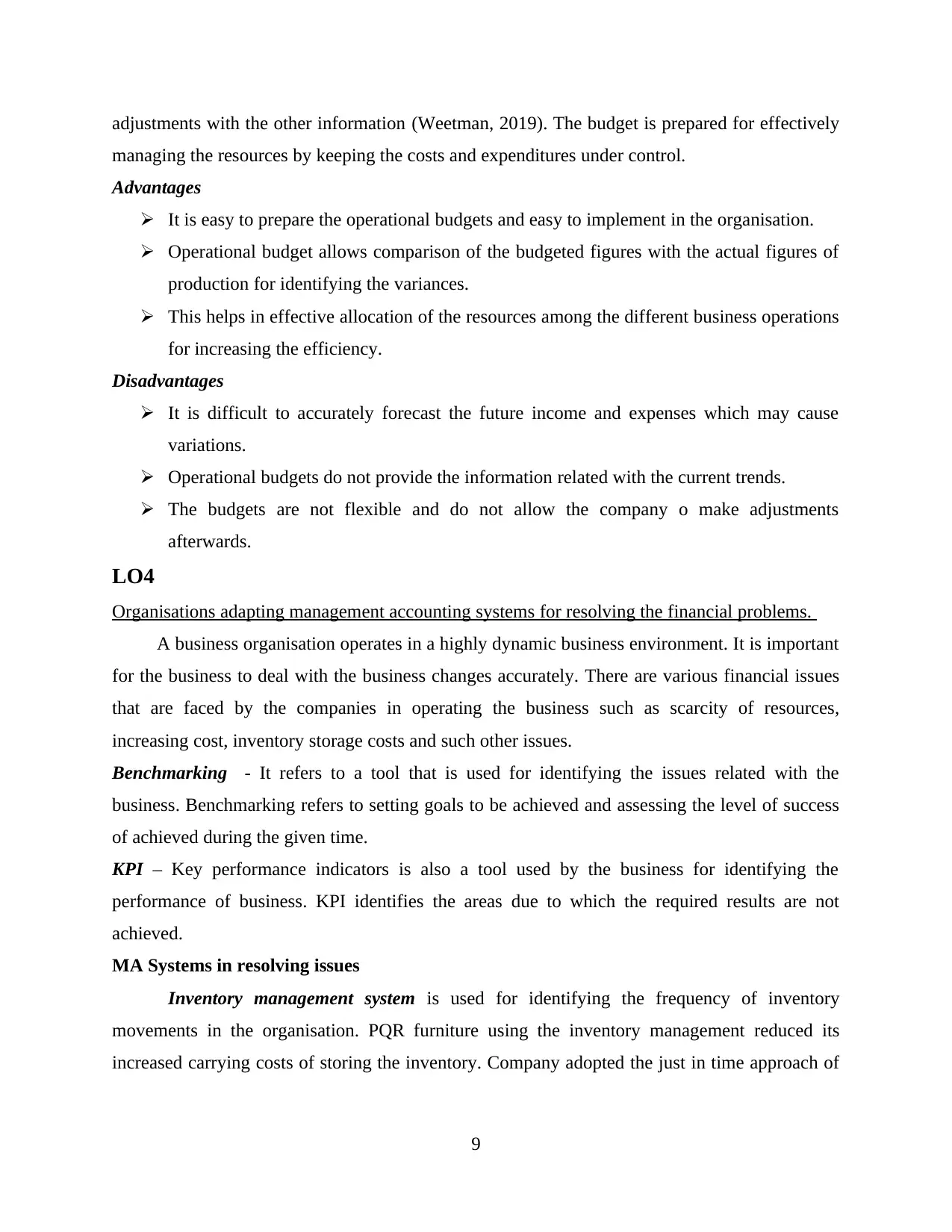
adjustments with the other information (Weetman, 2019). The budget is prepared for effectively
managing the resources by keeping the costs and expenditures under control.
Advantages
It is easy to prepare the operational budgets and easy to implement in the organisation.
Operational budget allows comparison of the budgeted figures with the actual figures of
production for identifying the variances.
This helps in effective allocation of the resources among the different business operations
for increasing the efficiency.
Disadvantages
It is difficult to accurately forecast the future income and expenses which may cause
variations.
Operational budgets do not provide the information related with the current trends.
The budgets are not flexible and do not allow the company o make adjustments
afterwards.
LO4
Organisations adapting management accounting systems for resolving the financial problems.
A business organisation operates in a highly dynamic business environment. It is important
for the business to deal with the business changes accurately. There are various financial issues
that are faced by the companies in operating the business such as scarcity of resources,
increasing cost, inventory storage costs and such other issues.
Benchmarking - It refers to a tool that is used for identifying the issues related with the
business. Benchmarking refers to setting goals to be achieved and assessing the level of success
of achieved during the given time.
KPI – Key performance indicators is also a tool used by the business for identifying the
performance of business. KPI identifies the areas due to which the required results are not
achieved.
MA Systems in resolving issues
Inventory management system is used for identifying the frequency of inventory
movements in the organisation. PQR furniture using the inventory management reduced its
increased carrying costs of storing the inventory. Company adopted the just in time approach of
9
managing the resources by keeping the costs and expenditures under control.
Advantages
It is easy to prepare the operational budgets and easy to implement in the organisation.
Operational budget allows comparison of the budgeted figures with the actual figures of
production for identifying the variances.
This helps in effective allocation of the resources among the different business operations
for increasing the efficiency.
Disadvantages
It is difficult to accurately forecast the future income and expenses which may cause
variations.
Operational budgets do not provide the information related with the current trends.
The budgets are not flexible and do not allow the company o make adjustments
afterwards.
LO4
Organisations adapting management accounting systems for resolving the financial problems.
A business organisation operates in a highly dynamic business environment. It is important
for the business to deal with the business changes accurately. There are various financial issues
that are faced by the companies in operating the business such as scarcity of resources,
increasing cost, inventory storage costs and such other issues.
Benchmarking - It refers to a tool that is used for identifying the issues related with the
business. Benchmarking refers to setting goals to be achieved and assessing the level of success
of achieved during the given time.
KPI – Key performance indicators is also a tool used by the business for identifying the
performance of business. KPI identifies the areas due to which the required results are not
achieved.
MA Systems in resolving issues
Inventory management system is used for identifying the frequency of inventory
movements in the organisation. PQR furniture using the inventory management reduced its
increased carrying costs of storing the inventory. Company adopted the just in time approach of
9
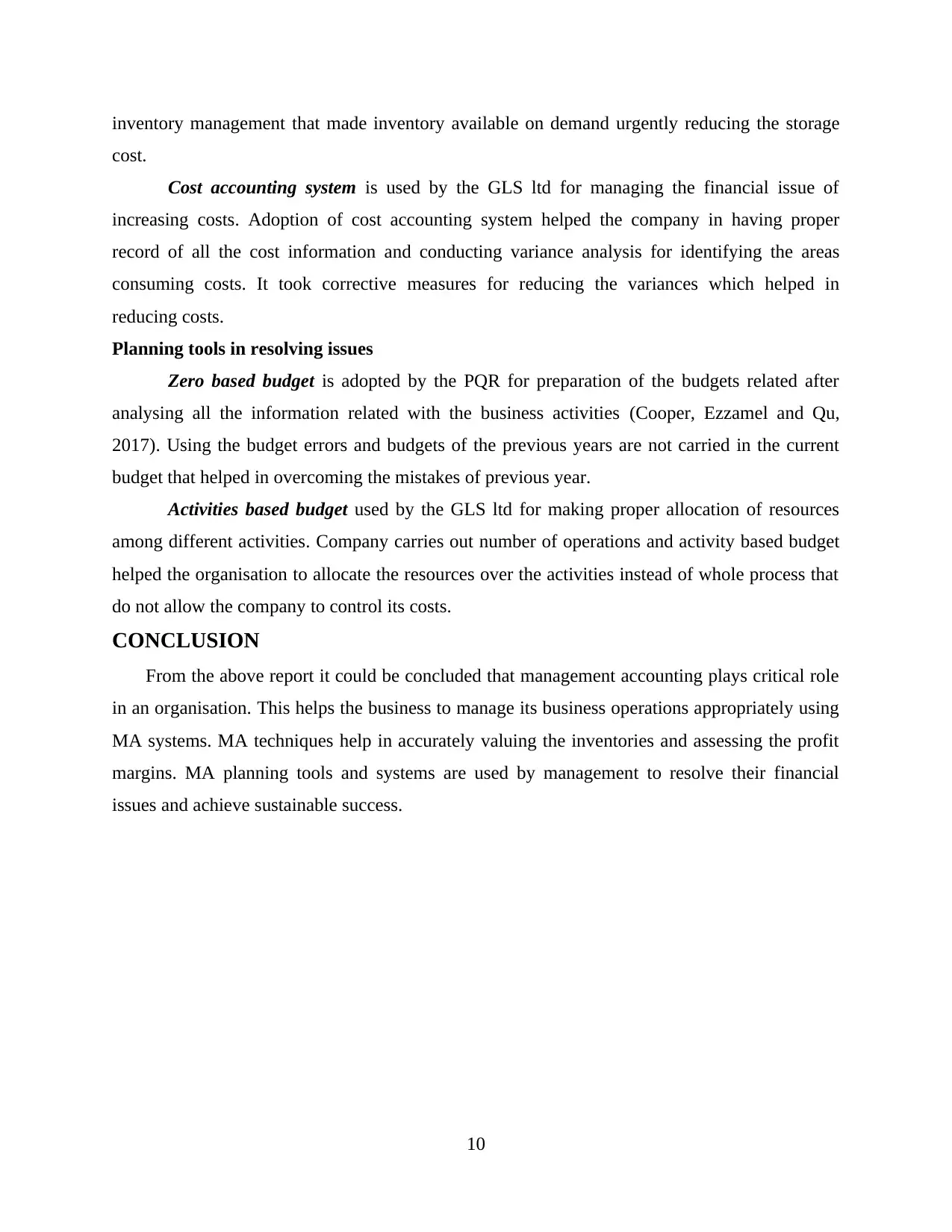
inventory management that made inventory available on demand urgently reducing the storage
cost.
Cost accounting system is used by the GLS ltd for managing the financial issue of
increasing costs. Adoption of cost accounting system helped the company in having proper
record of all the cost information and conducting variance analysis for identifying the areas
consuming costs. It took corrective measures for reducing the variances which helped in
reducing costs.
Planning tools in resolving issues
Zero based budget is adopted by the PQR for preparation of the budgets related after
analysing all the information related with the business activities (Cooper, Ezzamel and Qu,
2017). Using the budget errors and budgets of the previous years are not carried in the current
budget that helped in overcoming the mistakes of previous year.
Activities based budget used by the GLS ltd for making proper allocation of resources
among different activities. Company carries out number of operations and activity based budget
helped the organisation to allocate the resources over the activities instead of whole process that
do not allow the company to control its costs.
CONCLUSION
From the above report it could be concluded that management accounting plays critical role
in an organisation. This helps the business to manage its business operations appropriately using
MA systems. MA techniques help in accurately valuing the inventories and assessing the profit
margins. MA planning tools and systems are used by management to resolve their financial
issues and achieve sustainable success.
10
cost.
Cost accounting system is used by the GLS ltd for managing the financial issue of
increasing costs. Adoption of cost accounting system helped the company in having proper
record of all the cost information and conducting variance analysis for identifying the areas
consuming costs. It took corrective measures for reducing the variances which helped in
reducing costs.
Planning tools in resolving issues
Zero based budget is adopted by the PQR for preparation of the budgets related after
analysing all the information related with the business activities (Cooper, Ezzamel and Qu,
2017). Using the budget errors and budgets of the previous years are not carried in the current
budget that helped in overcoming the mistakes of previous year.
Activities based budget used by the GLS ltd for making proper allocation of resources
among different activities. Company carries out number of operations and activity based budget
helped the organisation to allocate the resources over the activities instead of whole process that
do not allow the company to control its costs.
CONCLUSION
From the above report it could be concluded that management accounting plays critical role
in an organisation. This helps the business to manage its business operations appropriately using
MA systems. MA techniques help in accurately valuing the inventories and assessing the profit
margins. MA planning tools and systems are used by management to resolve their financial
issues and achieve sustainable success.
10
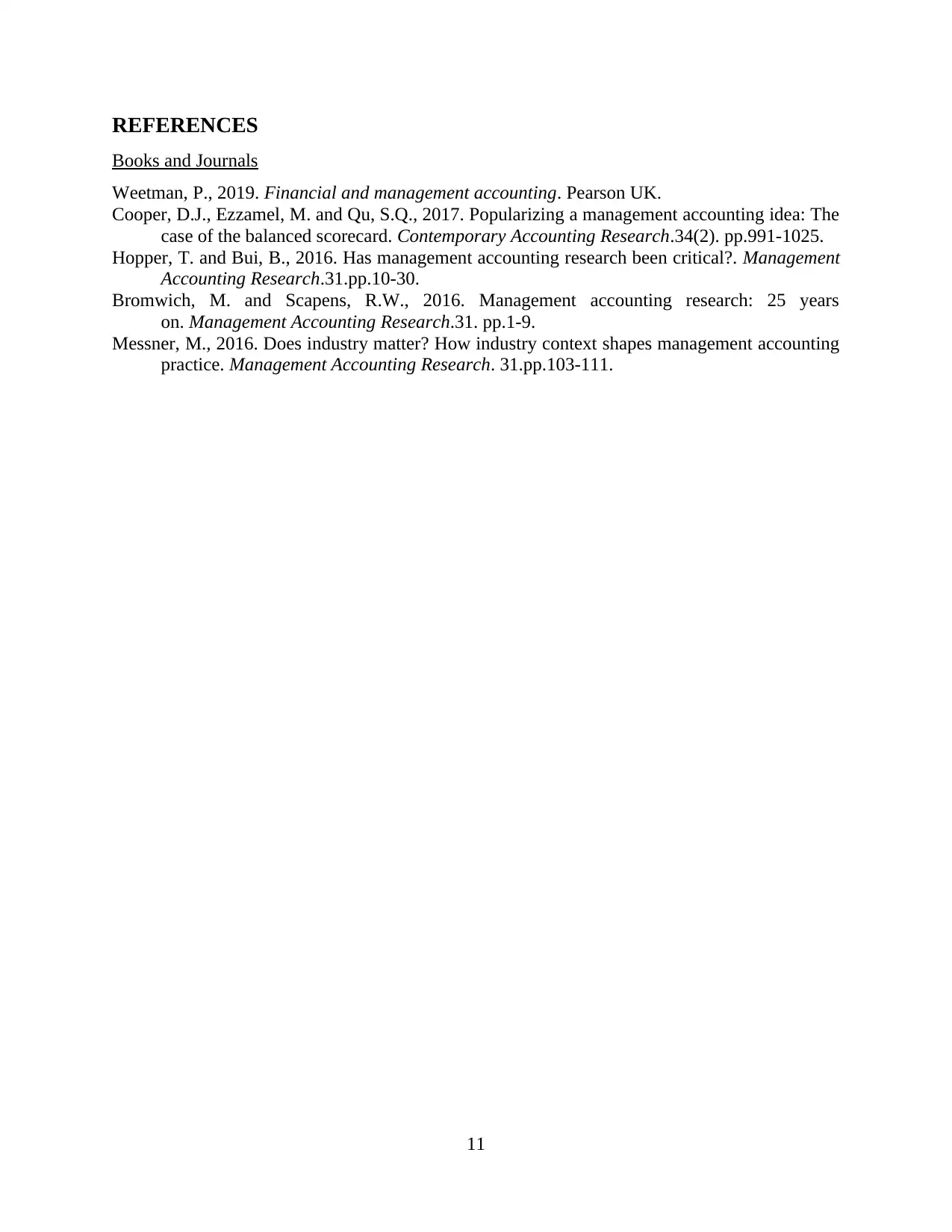
REFERENCES
Books and Journals
Weetman, P., 2019. Financial and management accounting. Pearson UK.
Cooper, D.J., Ezzamel, M. and Qu, S.Q., 2017. Popularizing a management accounting idea: The
case of the balanced scorecard. Contemporary Accounting Research.34(2). pp.991-1025.
Hopper, T. and Bui, B., 2016. Has management accounting research been critical?. Management
Accounting Research.31.pp.10-30.
Bromwich, M. and Scapens, R.W., 2016. Management accounting research: 25 years
on. Management Accounting Research.31. pp.1-9.
Messner, M., 2016. Does industry matter? How industry context shapes management accounting
practice. Management Accounting Research. 31.pp.103-111.
11
Books and Journals
Weetman, P., 2019. Financial and management accounting. Pearson UK.
Cooper, D.J., Ezzamel, M. and Qu, S.Q., 2017. Popularizing a management accounting idea: The
case of the balanced scorecard. Contemporary Accounting Research.34(2). pp.991-1025.
Hopper, T. and Bui, B., 2016. Has management accounting research been critical?. Management
Accounting Research.31.pp.10-30.
Bromwich, M. and Scapens, R.W., 2016. Management accounting research: 25 years
on. Management Accounting Research.31. pp.1-9.
Messner, M., 2016. Does industry matter? How industry context shapes management accounting
practice. Management Accounting Research. 31.pp.103-111.
11
1 out of 13
Related Documents
Your All-in-One AI-Powered Toolkit for Academic Success.
+13062052269
info@desklib.com
Available 24*7 on WhatsApp / Email
![[object Object]](/_next/static/media/star-bottom.7253800d.svg)
Unlock your academic potential
© 2024 | Zucol Services PVT LTD | All rights reserved.





